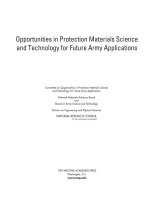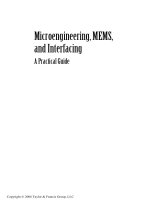- Trang chủ >>
- Khoa Học Tự Nhiên >>
- Vật lý
nanoscience and technology series. microfluid mechanics, 2006, p.368
Bạn đang xem bản rút gọn của tài liệu. Xem và tải ngay bản đầy đủ của tài liệu tại đây (8.24 MB, 368 trang )
Microfluid
Mechanics
Nanoscience and Technology Series
Omar Manasreh, Series Editor
MICHAEL H. PETERS
●
Molecular Thermodynamics and Transport
KENNETH GILLEO
●
MEMS/MOEM Packaging
NICOLAE O. LOBONTIU
●
Mechanical Design of Microresonators
ROBERTO PAIELLA
●
Intersubband Transitions in Quantum Structures
JOSEPH H. KOO
●
Polymer Nanocomposites
JENS W. TOMM AND JUAN JIMENEZ
●
Quantum-Well High-Power
Laser Arrays
Microfluid
Mechanics
PrinciplesandModeling
William W. Liou
Yichuan Fang
Department of Mechanical and
Aeronautical Engineering
Western Michigan University
Kalamazoo, Michigan
McGraw-Hill
New York Chicago San Francisco Lisbon London Madrid
Mexico City Milan New Delhi San Juan Seoul
Singapore Sydney Toronto
Copyright © 2006 by The McGraw-Hill Companies, Inc. All rights reserved. Manufactured in the
United States of America. Except as permitted under the United States Copyright Act of 1976, no part
of this publication may be reproduced or distributed in any form or by any means, or stored in a data-
base or retrieval system, without the prior written permission of the publisher.
0-07-158888-4
The material in this eBook also appears in the print version of this title: 0-07-144322-3.
All trademarks are trademarks of their respective owners. Rather than put a trademark symbol after
every occurrence of a trademarked name, we use names in an editorial fashion only, and to the
benefit of the trademark owner, with no intention of infringement of the trademark. Where such
designations appear in this book, they have been printed with initial caps.
McGraw-Hill eBooks are available at special quantity discounts to use as premiums and sales
promotions, or for use in corporate training programs. For more information, please contact George
Hoare, Special Sales, at or (212) 904-4069.
TERMS OF USE
This is a copyrighted work and The McGraw-Hill Companies, Inc. (“McGraw-Hill”) and its licensors
reserve all rights in and to the work. Use of this work is subject to these terms. Except as permitted
under the Copyright Act of 1976 and the right to store and retrieve one copy of the work, you may not
decompile, disassemble, reverse engineer, reproduce, modify, create derivative works based upon,
transmit, distribute, disseminate, sell, publish or sublicense the work or any part of it without
McGraw-Hill’s prior consent. You may use the work for your own noncommercial and personal use;
any other use of the work is strictly prohibited. Your right to use the work may be terminated if you
fail to comply with these terms.
THE WORK IS PROVIDED “AS IS.” McGRAW-HILL AND ITS LICENSORS MAKE NO
GUARANTEES OR WARRANTIES AS TO THE ACCURACY, ADEQUACY OR COMPLETE-
NESS OF OR RESULTS TO BE OBTAINED FROM USING THE WORK, INCLUDING ANY
INFORMATION THAT CAN BE ACCESSED THROUGH THE WORK VIA HYPERLINK OR
OTHERWISE, AND EXPRESSLY DISCLAIM ANY WARRANTY, EXPRESS OR IMPLIED,
INCLUDING BUT NOT LIMITED TO IMPLIED WARRANTIES OF MERCHANTABILITY OR
FITNESS FOR A PARTICULAR PURPOSE. McGraw-Hill and its licensors do not warrant or
guarantee that the functions contained in the work will meet your requirements or that its operation
will be uninterrupted or error free. Neither McGraw-Hill nor its licensors shall be liable to you or
anyone else for any inaccuracy, error or omission, regardless of cause, in the work or for any damages
resulting therefrom. McGraw-Hill has no responsibility for the content of any information accessed
through the work. Under no circumstances shall McGraw-Hill and/or its licensors be liable for any
indirect, incidental, special, punitive, consequential or similar damages that result from the use of or
inability to use the work, even if any of them has been advised of the possibility of such damages. This
limitation of liability shall apply to any claim or cause whatsoever whether such claim or cause
arises in contract, tort or otherwise.
DOI: 10.1036/0071443223
Contents
Preface ix
Chapter 1. Introduction 1
References 4
Chapter 2. Basic Kinetic Theory 5
2.1 Molecular Model 5
2.2 Micro and Macroscopic Properties 6
2.3 Binary Collisions 11
2.3.1 Kinematics 11
2.3.2 Dynamics and postcollision properties 14
2.3.3 Molecular force field models 19
2.4 Statistical Gas Properties 23
2.5 Position and Velocity Distribution Functions 27
2.6 Boltzmann Equation and Maxwellian Distribution Function 30
Appendix 2A: Some Useful Integrals 38
References 38
Chapter 3. Microfluid Flow Properties 39
3.1 Fundamental Flow Physics 39
3.2 Surface Phenomena 43
3.3 Basic Modeling Approaches 44
References 45
Chapter 4. Moment Method: Navier-Stokes and Burnett Equations 47
4.1 Introduction 47
4.2 Moment Equations 48
4.3 The Chapman-Enskog Expansion 54
4.3.1 The Krook equation 55
4.3.2 The Boltzmann equation 58
v
For more information about this title, click here
vi Contents
4.4 Closure Models 59
4.4.1 First-order modeling 59
4.4.2 Second-order modeling 62
4.5 A Numerical Solver for the Burnett Equations 67
4.5.1 Numerical method 68
4.5.2 An example of NB2D results 71
Appendix 4A: Coefficients for Maxwellian Molecules 74
Appendix 4B: First-Order and Second-Order Metrics of Transformation 75
Appendix 4C: Jacobian Matrices 79
References 81
Chapter 5. Statistical Method: Direct Simulation Monte Carlo Method
and Information Preservation Method 83
5.1 Conventional DSMC 83
5.1.1 Overview 83
5.1.2 Methodology 86
5.1.3 Binary elastic collisions 89
5.1.4 Collision sampling techniques 91
5.1.5 Cell schemes 92
5.1.6 Sampling of macroscopic properties 94
5.2 DSMC Accuracy and Approximation 96
5.2.1 Relationship between DSMC and Boltzmann equation 96
5.2.2 Computational approximations and input data 98
5.3 Information Preservation Method 99
5.3.1 Overview 99
5.3.2 IP governing equations 102
5.3.3 DSMC modeling for the information preservation equations 103
5.3.4 Energy flux model for the preserved temperature 105
5.3.5 IP implementation procedures 107
5.4 DSMC-IP Computer Program and Applications 113
5.4.1 IP1D program 113
5.4.2 IP1D applications to microCouette flows 116
5.5 Analysis of the Scatter of DSMC and IP 119
Appendix 5A: Sampling from a Probability Distribution Function 124
Appendix 5B: Additional Energy Carried by Fast Molecules Crossing
a Surface 127
Appendix 5C: One-Dimensional DSMC-IP Computer Program 129
References 154
Chapter 6. Parallel Computing and Parallel Direct Simulation
Monte Carlo Method 157
6.1 Introduction 157
6.2 Cost-Effective Parallel Computing 158
6.2.1 Parallel architecture 158
6.2.2 Development of HPCC 159
6.2.3 Beowulf system 162
6.2.4 Parallel programming 164
Contents vii
6.3 Parallel Implementation of DSMC 165
6.3.1 Data distribution 167
6.3.2 Data communication 168
6.3.3 A parallel machine 170
6.4 Parallel Performance of PDSMC 171
References 173
Chapter 7. Gas–Surface Interface Mechanisms 175
7.1 Introduction 175
7.2 Phenomenological Modeling 179
7.2.1 Specular and diffusive reflection models of Maxwell 179
7.2.2 Cercignani, Lampis, and Lord model 180
7.3 DSMC Implementation 182
7.3.1 Specular reflection 183
7.3.2 Diffusive reflection 183
7.3.3 CLL model 185
7.4 Wall-Slip Models for Continuum Approaches 187
References 191
Chapter 8. Development of Hybrid Continuum/Particle Method 193
8.1 Overview 193
8.2 Breakdown Parameters 194
8.3 Hybrid Approaches for Microfluid Flow 196
8.4 Development of Additional Hybrid Approaches 196
8.5 Remarks 198
References 198
Chapter 9. Low-Speed Microflows 201
9.1 Introduction 201
9.2 Analytical Flow Solutions 201
9.2.1 MicroCouette flows 201
9.2.2 MicroPoiseuille flows 204
9.3 Numerical Flow Simulations 207
9.3.1 Subsonic flow boundary conditions 207
9.3.2 MicroCouette flows 210
9.3.3 MicroPoiseuille flows 213
9.3.4 Patterned microchannel flow 226
9.3.5 Microchannels with surface roughness 230
References 235
Chapter 10. High-Speed Microflows 237
10.1 Introduction 237
10.2 High-Speed Channel Flows 237
References 248
viii Contents
Chapter 11. Perturbation in Microflows 249
11.1 Introduction 249
11.2 Forced MicroCouette Flows 250
11.2.1 Flows in two-dimensional planes 253
11.2.2 Three-dimensional flows 260
11.3 MicroRayleigh-Benard Flows 302
11.3.1 Two-dimensional flows 307
11.3.2 Three-dimensional flows 318
References 334
Index 337
Preface
This book is written as a textbook for an analytical-oriented microfluid
flow course with graduate students who, preferably, have already taken
an advanced fluid mechanics course. The derivations of the equations
are presented, whenever possible, in a fairly detailed manner. The
intent is that, even without the help of an instructor, students can self-
navigate through the materials with confidence and come away with a
successful learning experience. Similarly, practicing engineers who are
interested in the subject should also be able to pick up the book and fol-
low the flow of the contents without much difficulty. Some background
in modern numerical computation tools will help the readers getting
the full benefit of the two computer programs, NB2D and DSMC-IP, as-
sociated with the book. In fact, it is highly recommended that readers
do make use of these Fortran programs.
The book begins with an introduction to the kinetic theory of gas and
the Boltzmann equation to build the foundation to the later mathemat-
ical modeling approaches. With the dilute gas assumption, the nature
of the micro gas flows allows the direct application of the Chapman-
Enskog theory, which then brings in the modeling equations at the
various orders of the Knudsen number in Chapter 4. The direct simu-
lation Monte Carlo (DSMC) method and the information preservation
(IP) method are described as the numerical tools to provide solutions to
the Boltzmann equation when the Knudsen number is high. The later
chapters cover the hybrid approaches and the important surface mech-
anisms. Some examples of micro gas flows at high and low speeds are
shown. One interesting aspect of micro gas flows that is yet to see ex-
tensive examination in the literature is the characteristics of the flow
disturbances at microscales. Chapter 11 provides a detailed description
of some of our preliminary studies in this area.
Although a part of the content of the book has been used in a one-
semester graduate level microfluid dynamics course at Western
Michigan University, the book is best used as a textbook for a two-
semester course. Chapters 1 to 4 provide the introductory content for
ix
Copyright © 2006 by The McGraw-Hill Companies, Inc. Click here for terms of use.
x Preface
the basic mathematical and the physical aspects of micro gas flows. The
computer program NB2D may be used, for example, as project exercises.
The second part would emphasize the DSMC and the IP solution meth-
ods, and their parallelization. The computer program DSMC-IP can be
used for term project type of assignments. In the situation where the
analytical microfluid course is precededby another experiment-oriented
course on microfabrication or microengineering, and the students
have already had somewhat extensive knowledge of micro gas flows,
the instructor may wish to concentrate on Chapters 2, 4, and 5 in the
lectures and leave the rest as reading assignments. When the book is
used in a 16-to-20-hour short-course setting, the instructor may wish to
highlight the materials from Chapters 2, 4, 5, and 7. It might be a good
idea to provide opportunities to run at least one of the two computer
programs onsite. Chapters 1, 3, and 10 can be assigned as overnight
reading materials.
The book does not contain extensive updates and details on the cur-
rent engineering microfluidic devices. We feel that the book’s focus is
on the fundamental aspects of mirofluid flows and there is a myriad of
readily available information on the technologies and the many differ-
ent microfluidic device applications that have been cleverly designed
and painstakingly manufactured by experts in the field. Also, since
new devices are being brought to light almost daily, we feel that what
is current at the time of this writing may become outdated within a few
years.
A portion of the work the authors have accomplished at Western
Michigan University has been performed under the support of NASA
Langley Research Center. Near the completion of the manuscript, the
second author moved to the Georgia Institute of Technology.
We appreciate the help of Dr. James Moss for reviewing a part of the
manuscript. Thanks should go to those at McGraw Hill who worked on
the book and to those who reviewed it. We should also thank Jin Su
and Yang Yang for their work on the codes. The first author (WWL)
would like to thank the unconditional support and patience of his wife,
Shiou-Huey Lee, during this writing and the love from his children,
Alex and Natalie.
William W. Liou
Kalamazoo, Michigan
Yichuan Fang
Atlanta, Georgia
Microfluid
Mechanics
This page intentionally left blank
Chapter
1
Introduction
Microelectromechanical systems (MEMS) are considered one of the
major advances of industrial technologies in the past decades. MEMS
technology was derived initially from the integrated circuit (IC) fab-
rication technologies. Now, microfabrication is a diverse spectrum of
processing techniques that involve a wide range of disciplines from
chemical sciences to plastic molding. As the name suggests, MEMS cov-
ers micron-sized, electrically and/or mechanically driven devices. Com-
pared with the conventional mechanical or electrical systems, these
MEMS devices are five to six orders of magnitude smaller in size. In
fact, these dimensions are in the same range as the average diameter
of human hair (about 50 µm, 50 × 10
−6
m, or 50 µm). An MEMS de-
vice can be a single piece of hardware that produces outputs directly
based on the inputs from external sources. The outputs can be me-
chanical and fluidic movement, electrical charges, analog signals, and
digital signals. Often several microcomponents are integrated, such as
the lab-on-a-chip device, which performs the multistage processing of
the inputs and produces several different types of outputs, all in one
single miniature device. The small sizes of MEMS make them portable
and implantable. The manufacturing cost of MEMS is far from pro-
hibitive because of the wide use of the batch-processing technologies
that grow out of the well-developed IC industry. MEMS, therefore, of-
fer opportunities to many areas of application, such as biomedical and
information technology, that were thought not achievable using conven-
tional devices. Estimates of the potential commercial market size were
as high as billions of U.S. dollars by 2010.
Since the early work of Tai et al. (1989) and Mehregany et al. (1990)
on the surface-machined micromotors, there has been an explosive
growth of the number and the types of potential application of MEMS.
1
Copyright © 2006 by The McGraw-Hill Companies, Inc. Click here for terms of use.
2 Chapter One
Accompanying this growth is the significant increase of new journals
that are dedicated to reporting advances in the field. The universal use
of the Internet also helps disseminate new MEMS knowledge quickly
and hasten its development effectively. There are also a number of ti-
tles written by distinguished researchers in the field. [a sample of them
would include Gad-el-Hak (2002), Karniadakis and Beskok (2002), Koch
et al. (2000), Nguyen and Wereley (2002), and Li (2004)] MEMS re-
lated technologies, ranging from electrokinetics and microfabrication
to applications, can be readily found in these and many other forms of
publications and media.
As more new applications are proposed and new MEMS devices
designed, it was often found that measured quantities could not be in-
terpreted by using conventional correlations developed for macro scale
devices. Electric power needed to drive a micromotor was extraordinar-
ily high. The properties of MEMS materials, such as Young’s modulus,
have been found to differ from that of the bulk material. For MEMS that
use fluid as the working media, or a microfluidic device, for instance, the
surface mechanisms are more important than mechanisms that scale
with the volume. Overcoming surface stiction was found to be important
in the early work on micromotors. The surface tension is perhaps among
the most challenging issues in microfluidic devices that involve the use
of liquid for transporting, sensing, and control purposes. The mass flow
rate of microchannels of gas and liquid flows in simple straight mi-
crochannels and pipes were found to transition to turbulence at a much
lower Reynolds number than their counterparts at the macro scales.
Due to the miniature size, there are uncertainties in measuring the var-
ious properties of MEMS, such as specimen dimensions, with sufficient
accuracy. Nevertheless, it has become increasingly apparent that the
physical mechanisms at work in these small-scale devices are different
from what can be extrapolated from what is known from experience with
macroscaled devices. There is a need to either reexamine or replace the
phenomenological modeling tools developed from observations of macro
scale devices.
This book covers the fundamentals of microfluid flows. The somewhat
limited scope, compared with other titles, allows a detailed examination
of the physics of the microfluids from an ab initio point of view. Since the
first principle theory is far less developed for liquids, the focus in this
writing is the microfluid flows of gas. The Boltzmann equation will be in-
troduced first as the mathematical model for micro gas flows. Analytical
solutions of the Boltzmann equation can be found for a limited num-
ber of cases. The Chapman-Enskog theory assumes that the velocity
distribution function of gas is a small perturbation of that in thermo-
dynamic equilibrium. The velocity distribution function is expressed as
a series expansion about the Knudsen number. The Chapman-Enskog
Introduction 3
theory is therefore adequate for micro gas flows where the Knudsen
number and the departure from local equilibrium are small. It will
be shown that the zeroth-order solution of the Chapman-Enskog the-
ory leads to the Euler equations and the first-order solution results
in the Navier-Stokes equations. The linear constitutive relations be-
tween the stress and strain, and that between the heat transfer and
temperature gradient, which are used in the derivation of the Navier-
Stokes equations from the continuum point of view of gas flow, are thus
valid only for very small Knudsen number. The second-order solution of
the Chapman-Enskog theory produces nonlinear closure models for the
stresses and heat fluxes. The resulting equations were referred to as
the Burnett equations. Two forms of the Burnett equations will be dis-
cussed. For micro gas flows of higher Knudsen number, the Boltzmann
equation should be used to model the micro gas flow behavior.
The analytical solutions of these various mathematical model equa-
tions for micro gas flows can be found for simple geometry and for
limited flow conditions, some of which are discussed in the appropri-
ate chapters. For many of the complex design of microfluidic devices,
the flow solutions can only be found by numerically solving the model
equations. To this end, two computer programs are provided in the
appendix section of the book. The programs are written using the stan-
dard FORTRAN language and can be compiled in any platforms. The
NB2D code solves the Navier-Stokes equations as well as two forms of
the Burnett equation. The all-speed numerical algorithm has been used
in the numerical discretization. The density-based numerical method
has been shown to be able to handle low-speed as well as high-speed
flows, and is appropriate for gas flows commonly seen in microdevices.
The DSMC/IP1D code uses the direct simulation Monte Carlo (DSMC)
method and the information preservation (IP) method to provide sim-
ulations of the gas microflow at the large Knudsen number. The IP
method has been shown to be exceptionally efficient in reducing the
statistical scatter inherent in the particle-based DSMC-like methods
when the flow speed is low. The two computer programs will provide
the readers with numerical tools to study the basic properties of micro
gas flows in a wide range of flow speeds and in a wide range of Knudsen
number. Examples of low- and high-speed micro gas flow simulations
are also presented in later chapters. One of the unsolved problems in
conventional macro scale fluid dynamics is associated with the flow
transition to turbulence. In Chap. 11, the behavior of the flow distur-
bances in two simulated micro gas flows is described.
The book is geared toward developing an appreciation of the basic
physical properties of micro gas flows. The computer software, cou-
pled with the necessary analytical background, enable the reader to
develop a detailed understanding of the fundamentals of microfluidic
4 Chapter One
flows and to further validate their findings using computer microflow
simulations. The knowledge can then be used in either further studies
of the microflows or in the practical design and control of microfludic
devices.
References
Gad-el-Hak, M., The MEMS Handbook, Boca Raton, FL, CRC Press, 2002.
Karniadakis, G.E. and Beskok, A., Microflows: Fundamentals and Simulation, Springer,
New York, 2002.
Koch, M., Evens, A., and Brunnshweiler, A., Microfluidic Technology and Applications,
Research Studies Press, Hertfordshire, England, 2000.
Li, D., Electrokinetics in Microfluidics, Interface Sciences and Technology, Vol. 2, Elsevier
Academic Press, London, UK, 2004.
Mehregany, M., Nagarkar, P., Senturia, S., and Lang, J., Operation of microfavricated
harmonic and ordinary side-drive motor, IEEE Micro Electro Mechanical System Work-
shop, Napa Valley, CA, 1990.
Nguyen, N T. and Wereley, S., Fundamentals and Applications of Microfluidic, Artech
House, Norwood, MA, 2002.
Tai, Y., Fan, L., and Muller, R., IC-Processed micro-motors: Design, technology and test-
ing, IEEE Micro Electro Mechanical System Workshop, Salt lake City, UT, 1989.
Chapter
2
Basic Kinetic Theory
2.1 Molecular Model
In kinetic theory, the composition of a gas is considered at the mi-
croscopic level. A gas is assumed to be made up of small individual
molecules that are constantly in a state of motion. The name molecule
can mean a single-atom molecule or a molecule with more than one
atom. In each atom, a nucleus is surrounded by orbiting electrons. The
internal structure of the molecule may change during an interaction
with other molecules, such as collision. Collisions with other molecules
occur continuously as the molecules move freely in their state of mo-
tion. Collision will also happen when a surface is present in its path.
The intermolecular collision causes the magnitude and the direction of
the velocity of the molecule to change, often in a discontinuous man-
ner. If there is no collective, or macroscopic, movement, the motion of
the molecule is completely random. This freedom of movement is not
shared by liquid or solid molecules.
A molecular model for gas would then describe the nature of the
molecule, such as the mass, the size, the velocity, and the internal state
of each molecule. A measure for the number of molecules per unit vol-
ume, or number density n, would also be a parameter. The model also
describes the force field acting between the molecules. The force field is
normally assumed to be spherically symmetric. This is physically rea-
sonable in light of the random nature of the large number of collisions
in most cases. The force field is then a function of the distance between
the molecules. Figure 2.1.1 shows a typical form of the force field F (r )
between two molecules with distance r. At a large distance, the weak at-
tractive force approaches zero. The attractive force increases as the dis-
tance decreases. In close range, the force reverses to become repulsive
5
Copyright © 2006 by The McGraw-Hill Companies, Inc. Click here for terms of use.
6 Chapter Two
d
F
r
∞
Rigid sphere model
Figure 2.1.1 Sketch of spherically symmetric inter-
molecular force field.
as the orbiting electrons of the two molecules intermingle. Analyses
with nonspherically symmetric force field are complicated. In fact, it is
generally found that, the exact form of the force field is less important
than other collision parameters. The force field of a simple rigid sphere
model is shown in Fig. 2.1.1. The model assumes an infinitive repulsive
force when the molecules are in contact and zero otherwise. The contact
occurs when the distance between the centers of the molecules are the
same as the assumed diameter of the sphere d. Use of the rigid sphere
model can lead to accurate results if the diameter d is properly chosen
according to some basic properties of the gas. The internal structure of
the molecules affects the energy content of the gas. With the nuclei and
the electrons in motion, the molecule can have, for instance, rotational
and vibrational modes of energy in addition to the energy associated
with the molecular translational motion.
These molecular quantities need to be related to macroscopic proper-
ties for analyses. This is especially true when there is a general macro-
scopic movement of the gas. As will be seen in the following section, a
macroscopic property is merely the sample averaged value of the corre-
sponding molecular quantity. The motion of the molecules is then not
completely random when there is macroscopic motion.
2.2 Micro and Macroscopic Properties
In this section, we will use a simplified model to introduce the rela-
tions between the molecular behavior and the macroscopic properties
of gases. We consider an equilibrium monatomic gas of single species
Basic Kinetic Theory 7
l
l
x
y
Figure 2.2.1 A planar projection
of a molecular path.
inside a cubic box at rest of length l on each side (see Fig. 2.2.1). A gas
in equilibrium would exhibit no gradients of macroscopic quantities in
space or time. The average velocity of the molecule is therefore zero.
Molecular motion is random with velocity vector c. The molecular ve-
locity components are c
x
, c
y
, and c
z
in the Cartesian coordinate sys-
tem (x, y, z). Again, molecules here can represent an atom, monatomic
molecules, diatomic molecules, or polyatomic gas molecules. Assuming
specular reflection at the wall, the x momentum change of a molecule
during a collision with the right, vertical side of the box is (2mc
x
) where
m denotes the molecular mass. If we assume that there are no inter-
molecular collisions, the rate of the momentum change, or the force F
x
exerted on the wall by the molecule, is
F
x
= (2mc
x
)
1
2l/c
x
=
mc
2
x
l
For a total number N molecules in the box, the total force becomes
F
x
=
N
mc
2
x
l
The pressure p
x
on the wall then is
p
x
=
F
x
A
=
F
x
l
2
=
N
mc
2
x
l
3
=
N
mc
2
x
V
8 Chapter Two
Similarly
p
y
=
N
mc
2
y
V
and p
z
=
N
mc
2
z
V
Therefore, pressure p becomes
p =
1
3
( p
x
+ p
y
+ p
z
)
=
N
m|c|
2
3V
(2.2.1)
=
2E
tr
3V
where E
tr
is the total energy of translation of the molecules
E
tr
=
N
m|c|
2
2
By using the total system mass M =
N
m = Nm,weget
p =
2E
tr
/M
3V /M
(2.2.2)
=
2
3
ρe
tr
where ρ is the density and e
tr
the molecular translational kinetic en-
ergy per unit mass, or the specific molecular translational kinetic en-
ergy. Therefore, from the kinetic theory point of view, the pressure is
proportional to the gas density and the specific translational kinetic
energy. The empirical equation of state for a thermally perfect gas can
provide pressure from the thermodynamics consideration. That is,
p = ρ RT
where R represents the gas constant. The two different expressions for
pressure will give the same quantity if
T =
2e
tr
3R
(2.2.3)
This equation relates the temperature defined in the classical ther-
modynamics to the specific kinetic energy of molecular translational
motion in kinetic theory. Therefore, temperature, a macroscopic gas
property, can then be used as a measure of the specific molecular energy.
Basic Kinetic Theory 9
We can also relate temperature and pressure to the average kinetic en-
ergy per molecule. For instance, Eq. (2.2.2) gives
p =
2
3
ρe
tr
=
2
3
ρ
M
(Me
tr
)
=
2
3
ρ
M
(Nˆe
tr
) (2.2.4)
=
2
3
N
V
ˆe
tr
=
2
3
n ˆe
tr
where
ˆe
tr
=
1
2N
N
|c|
2
denotes the average kinetic energy per molecule. Similarly, we can find
that
T =
2ˆe
tr
3k
(2.2.5)
where k is the Boltzmann constant. It is the ratio of the universal
gas constant
ˆ
R to the Avogadro’s number
ˆ
N . As this temperature in-
cludes only the translational kinetic energy, it is sometime referred to
as the translational kinetic temperature T
tr
. For monatomic gases, the
molecule can be assumed to possess translational kinetic energy only
and the translational kinetic temperature may simply be referred to as
the temperature. For diatomic and polyatomic molecules, the rotational
and the vibrational modes can also be associated with temperature. A
general principle of equipartition of energy states that for every part
of the molecular energy that can be expressed as the sum of square
terms, an average energy of kT/2 per molecule is contributed by each
such term. For instance, in the kinetic energy of translation, there are
three such terms: c
2
x
, c
2
y
, and c
2
z
. Therefore, Eq. (2.2.5) shows that
ˆe
tr
= 3
kT
2
Or
e
tr
= 3
RT
2
10 Chapter Two
In general, for a gas with ξ number of square terms, the average kinetic
energy is then
e = ξ
RT
2
The number of terms that can be expressed as quadratic in some ap-
propriate variables depends on the internal structure of the molecule.
For a diatomic gas, such as air, there are two additional rotational en-
ergy that can be expressed as square terms, therefore ξ = 5 and
e = 5
RT
2
The specific heat at constant volume c
v
is (5/2)R and
c
p
= c
v
+ R
= (7/2)R
The ratio of the specific heats
γ =
c
p
c
v
=
7
5
which is the value normally assumed for diatomic gases. Therefore, even
though the assumptions that the molecular collision can be ignored and
the molecular interaction with the wall being specular have greatly sim-
plified the gas behavior, the results are still valid. More rigorous deriva-
tion of these results can be found in Bird (1994) and Gombosi (1994).
To estimate the molecular speed by using the macroscopic properties,
divide both sides of Eq. (2.2.1) by the total mass M, then
p
ρ
=
1
3
N
m|c|
2
M
(2.2.6)
=
|c|
2
3
where
|c|
2
represents the mean-square molecular speed.
Note that we have defined a sample average ¯q as an average of a molec-
ular quantity q over all the molecules in the sample. That is
¯q =
1
N
N
q (2.2.7)
Basic Kinetic Theory 11
For example, the average molecular velocity is
¯
c =
1
N
N
c (2.2.8)
This is a macroscopic or stream velocity. The difference between the
molecular velocity and the stream velocity is called thermal or random
velocity
c
= c −
¯
c (2.2.9)
Note that
c
=
¯
c −
¯
c = 0 (2.2.10)
That is, the average thermal velocity is zero.
2.3 Binary Collisions
Molecular collisions are the most fundamental process in gases. Molec-
ular collision frequently occurs. There can be any number of molecules
involved in a collision. In Sec. 2.3.1 the kinematics and the dynamics of
collision that involves only two molecules, or binary collision, will be in-
troduced. Binary collision is most relevant to most microflow analyses
with rarefied gas effects.
2.3.1 Kinematics
We will assume that the size of the molecules is small and the molecules
can be regarded as point centers of the intermolecular force. The force
is along the direction connecting the centers of the molecules and de-
pends only on the relative positions of the molecules. The force is also
assumed conservative. Consider two molecules with masses m
1
and m
2
,
position vectors r
1
and r
2
, in a fixed Cartesian coordinate system (see
Fig. 2.3.1). The pre-collision velocities of the molecules are c
1
and c
2
,
respectively. The trajectories or orbits of the two particles are twisted
curves in space.
c
1
c
2
m
1
m
2
z
x
y
r
1
r
2
Figure 2.3.1 Binary collision.
12 Chapter Two
The location of the center of mass is
r
m
=
m
1
m
1
+ m
2
r
1
+
m
2
m
1
+ m
2
r
2
(2.3.1)
The velocity of the center of mass is
c
m
=
m
1
m
1
+ m
2
c
1
+
m
2
m
1
+ m
2
c
2
(2.3.2)
In an elastic collision, the linear momentum is conserved. Therefore,
m
1
c
1
+ m
2
c
2
= m
1
c
∗
1
+ m
2
c
∗
2
(2.3.3)
= (m
1
+ m
2
)c
m
where asterisk (
∗
) denotes post collision quantities. Equation (2.3.3)
shows that the velocity of the center of mass does not change in the
collision. The conservation of energy gives
m
1
c
2
1
+ m
2
c
2
2
= m
1
c
∗
1
2
+ m
2
c
∗
2
2
(2.3.4)
The relative location between the two molecules r is defined as
r = r
1
− r
2
The pre- and the post-collision velocities of m
1
relative to those of m
2
are
c
r
= c
1
− c
2
and c
∗
r
= c
∗
1
− c
∗
2
(2.3.5)
From Eqs. (2.3.2) and (2.3.5), one can write the pre-collision velocities
in terms of the center of mass velocity and the relative velocity
c
1
= c
m
+
m
2
m
1
+ m
2
c
r
and c
2
= c
m
−
m
1
m
1
+ m
2
c
r
(2.3.6)
Equation (2.3.6) shows that c
1
− c
m
// c
2
− c
m
. That is, in the center-of-
mass reference of frame, the approach velocities of the collision partner
are parallel to each other. For a spherically symmetric repulsive inter-
molecular force F
F = F e
r
(2.3.7)
=−
dU (r )
dr
e
r
U (r ) is the potential of the intermolecular force and e
r
the unit vector
along r. The conservative force field is a function of the distance between
the collision partner and is on the same plane formed by c
1
− c
m
and









